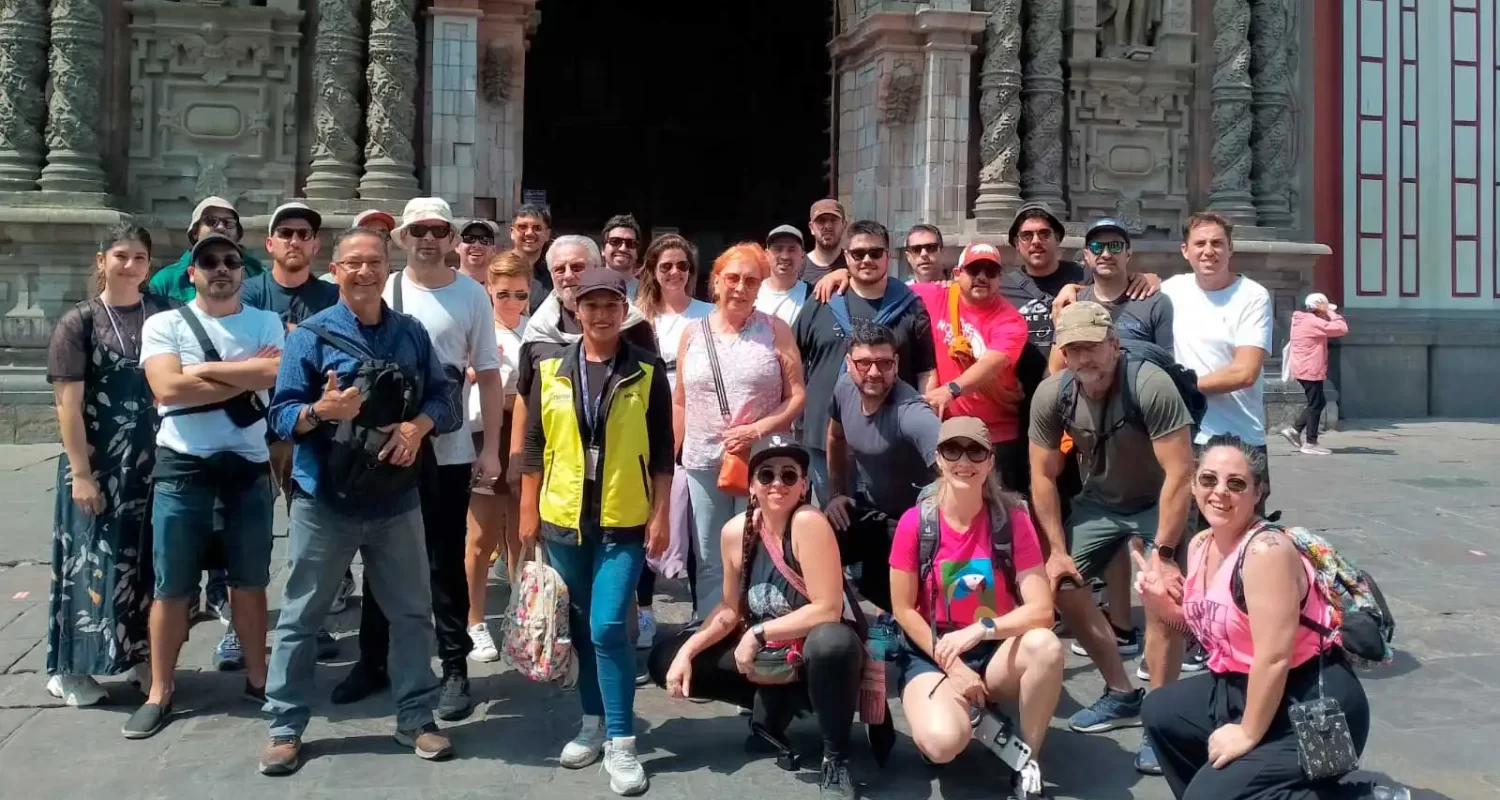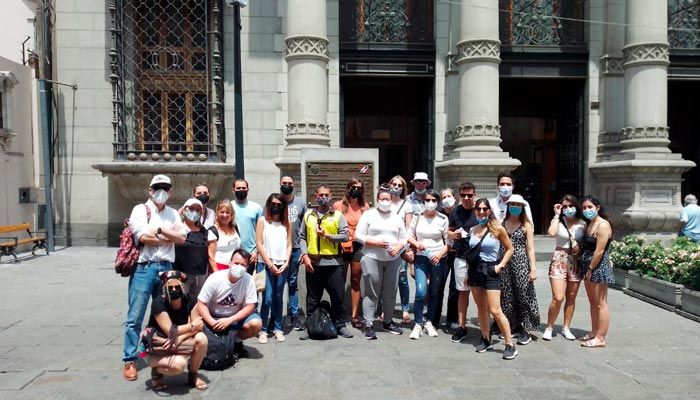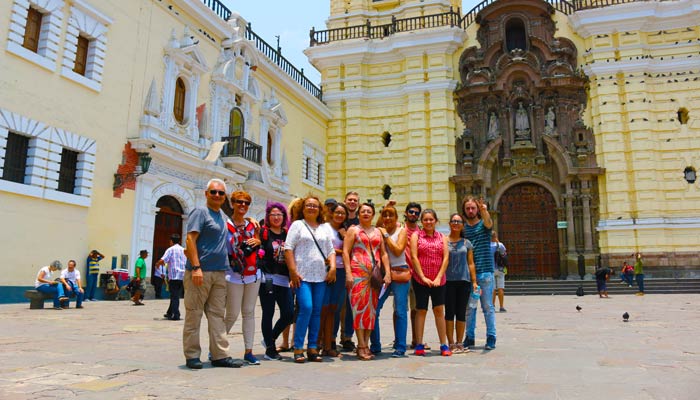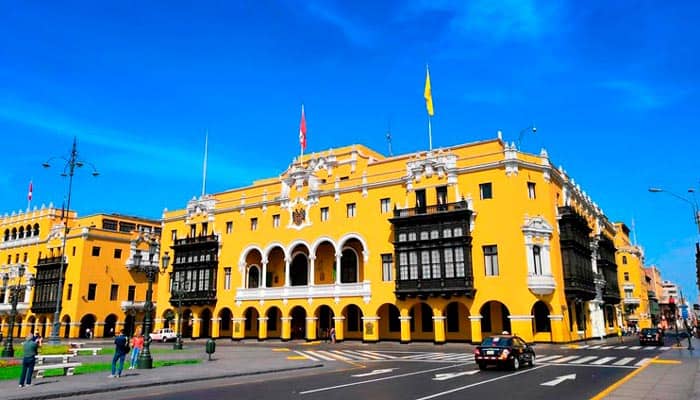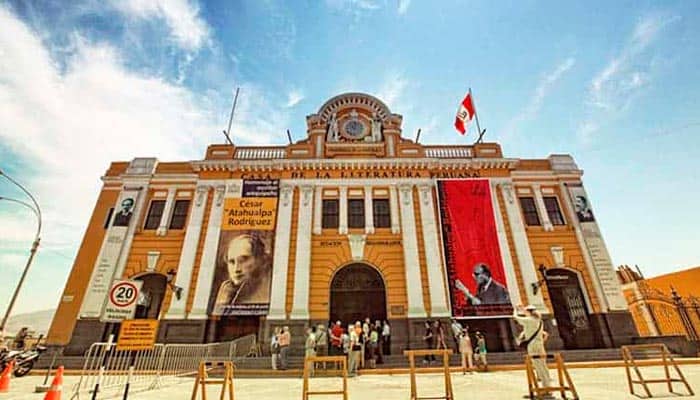
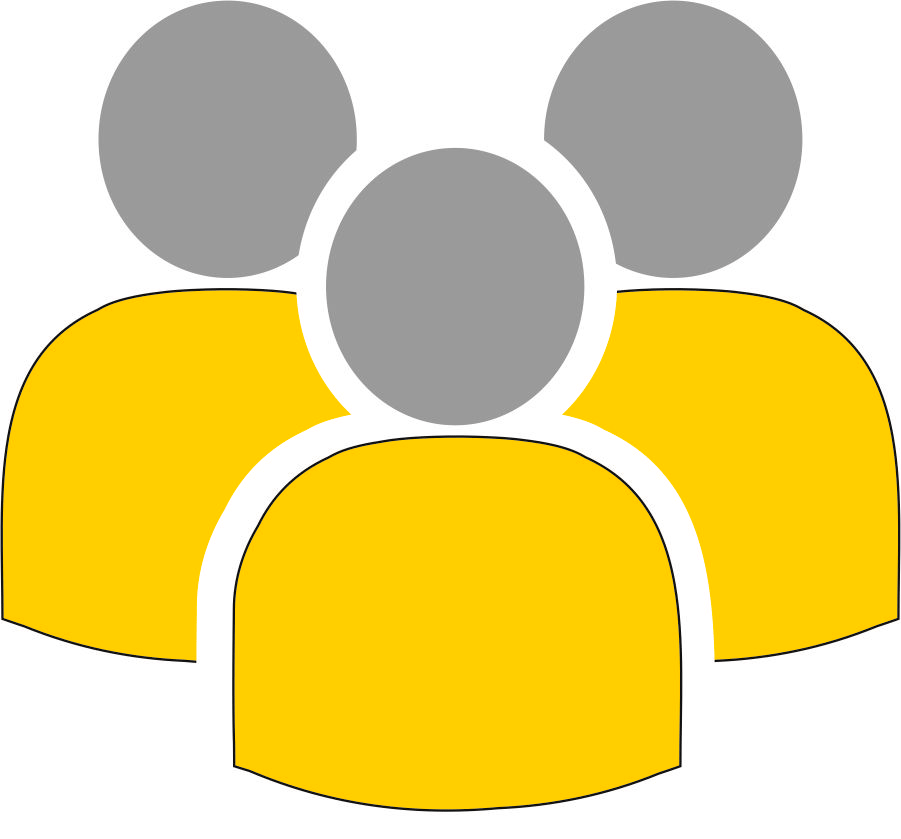

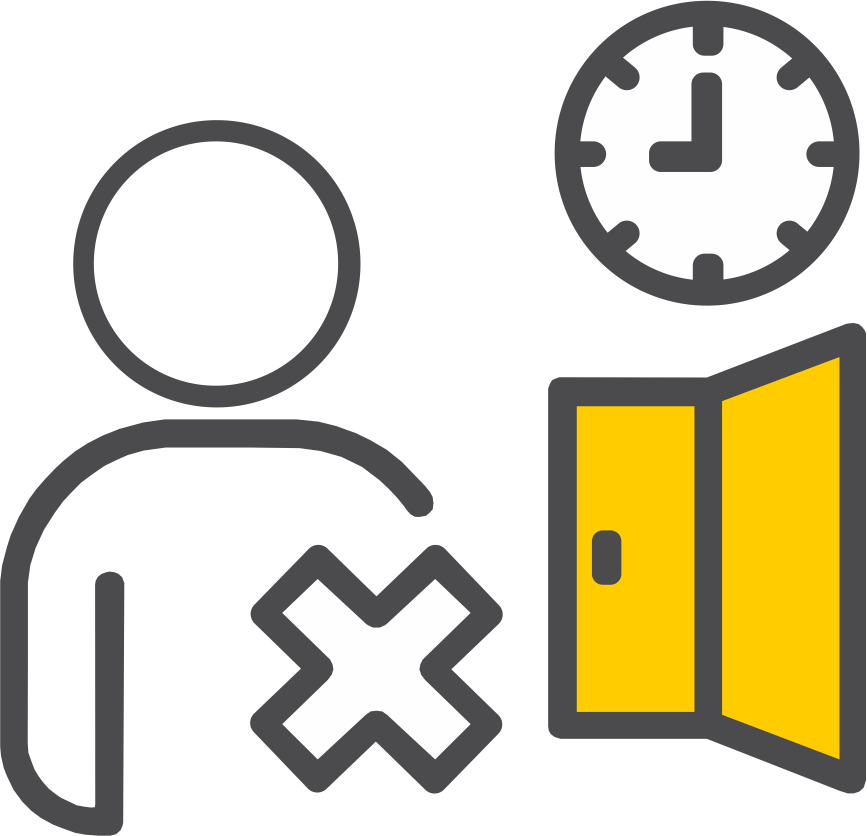
Join the best free walking tour of Lima’s historic centre — the old city — led by pioneering, professional guides who are 100% certified by the Government through the Ministry of Foreign Trade and Tourism.
OPERATION OF THIS TOUR
Book now! — even last-minute bookings are welcome. We’re running all our free tours of Lima from Monday to Saturday. If you’d like to book your Lima free tour for a Sunday, please visit this link.
PERUANOS:
Este free tour es solamente para extranjeros. Si eres peruano, reserva nuestro city tour por Lima.
HIGHLIGHTS
Meeting points
If you’re staying in Miraflores or a nearby area, we’ll be waiting for you at 10:00 hours at Pasaje Porta 132 (Oechsle mall). From there, we’ll head to Lima’s Historic Centre using the Metropolitano buses (Cost: 3.20 soles).
You can also find us at 11:00 hours (morning tour) and 15:00 hours (afternoon tour) right in front of La Merced Church (Jirón de la Unión 608). From this point, you’ll begin your walk through the streets of Lima, guided by one of our professional local guides.
At our meeting places, look for the yellow vest with the FWTP – IMW logo.
Jirón de la Unión
It’s the perfect place to begin your walk through the old town. Known as “Mercaderes” during colonial times, Jirón de la Unión connects the Plaza de Armas with Plaza San Martín. This “union” between the viceregal and republican parts of Lima is what gave it its current name.


Its eye-catching mansions were once home to wealthy and influential families. One of the most notable buildings is Casa O’Higgins. With its colonial architecture, it’s named after Bernardo O’Higgins, the father of the Republic of Chile, who lived there.
Today, the house is a cultural centre run by the Pontifical Catholic University of Peru. Once your free tour ends, we recommend popping in—admission is free, and there are both temporary and permanent exhibitions on display.

Other highlights along the way include the Casa Courret, specially designed for French photographer Eugène Courret who arrived in Lima in 1865, and the Casa Barragán, whose rooms would later house the famous Palais Concert.
The writer Abraham Valdelomar once said: “Peru is Lima, Lima is the Jirón de la Unión, the Jirón de la Unión is the Palais Concert, and the Palais Concert is me.” That quote reflects the cultural importance of this iconic café, cinema, and bar, which flourished between 1913 and 1930.
Since 1982, Jirón de la Unión has been a pedestrian-only street, making it easier for you to stroll towards Plaza de Armas—the next stop on your free walking tour through timeless, historic Lima.


Plaza de Armas
On the 18th of January 1535, the Spanish conquistador Francisco Pizarro founded the City of Kings, laying out what is now Lima’s Plaza de Armas and establishing the layout of today’s Historic Centre.
From its Spanish foundation, the Plaza de Armas—also known as the Main Square—has been the heart of political and religious power in both the city and the country. A place for gatherings and important events, it is surrounded by the Government Palace, the City Hall, the Archbishop’s Palace, and Lima’s grand Cathedral.
But the urban story of the Rímac Valley didn’t begin with the arrival of the Spanish. Many parts of today’s Lima were once home to ancient civilisations. You can still see that legacy in archaeological sites such as Huaca Pucllana.
And that’s not the only one—Puruchuco, Mateo Salado, and the oracle of Pachacamac are all key reminders of the Peruvian capital’s millennia-old history, where cultures like the Lima, Wari, and Inca once flourished.
When Pizarro founded the city, the area where the Plaza de Armas now stands was under the rule of a local chief called Taulichusco the Elder. Once you’re in the plaza, your guide will share even more about the historic heart of Lima.


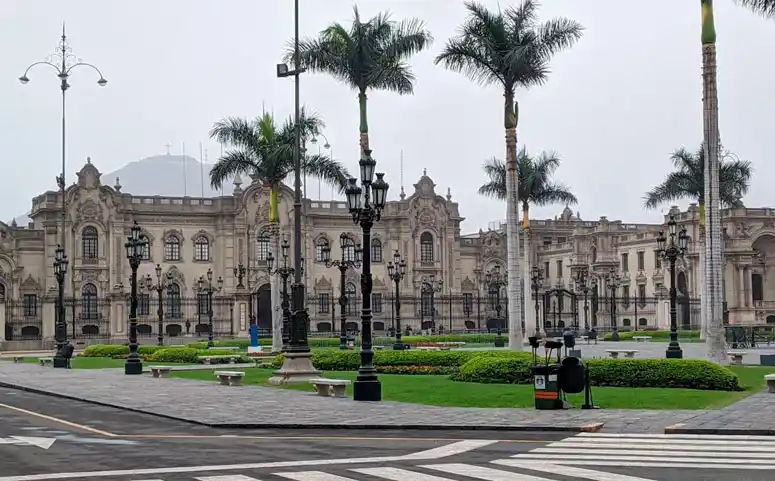
Changing of the guard (optional)
Every day at 12:00 p.m., the colourful and perfectly synchronised Changing of the Guard takes place in the Courtyard of Honour at the Government Palace—a military ceremony with roots going back to the colonial era.
If you join us on the morning free tour, you’ll have the chance to watch the Changing of the Guard. However, please note that for security reasons, there are times when the public is not allowed to view the ceremony.
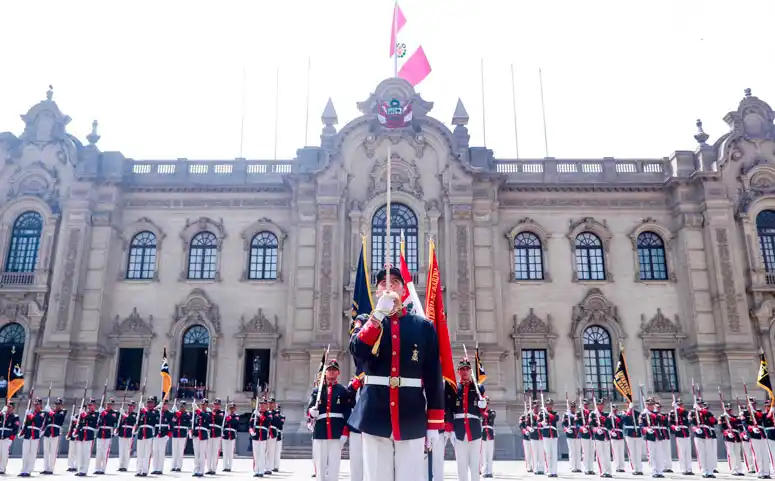
Presidential palace (external visit)
It’s the seat of the Executive Branch and the official residence of the President of the Republic of Peru. While its origins as a centre of power date back to pre-Hispanic and colonial times, the current building is purely republican in style.
The so-called “House of Pizarro” was seriously damaged by the earthquake of 1746. That wouldn’t be the only tragedy. On 3 July 1921—during the month celebrating the centenary of Peru’s independence—a fierce fire reduced the palace’s right wing to ashes.
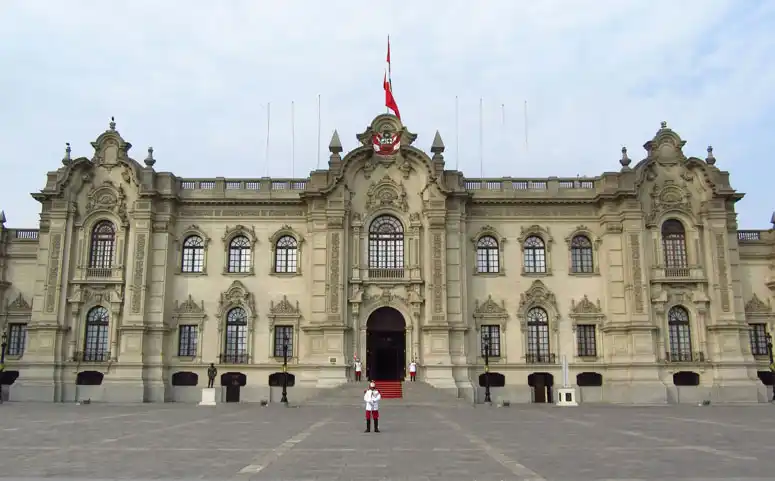
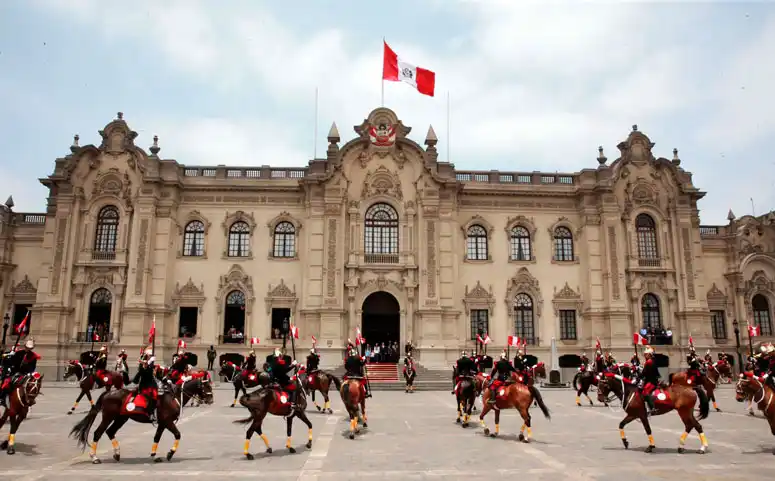
Reconstruction began in 1926, under the presidency of Augusto B. Leguía, and was completed in 1938 during the government of Óscar R. Benavides. French architect Claudio Sahut and Polish architect Ricardo de Jaxa Malachowski were in charge of the project.
According to historical accounts, the palace of Taulichusco—the Inca curaca (chief) of the Rímac Valley—once stood on the same site as the current government palace. When Pizarro arrived, the local ruler was sent to Chontay in the highlands of Lima.


His residence was then taken over by the conquistador and founder of Lima, who ordered the construction of a palace that would become the centre of viceregal power in Peru.
Cathedral Basilica (external visit)
In 1535, Francisco Pizarro ordered the construction of Lima’s first Cathedral atop the Inca temple known as Puma Inti, dedicating it to Our Lady of the Assumption.
However, that “House of God”, built in the young city, wouldn’t withstand the wrath of Pachamama (Mother Earth). The frequent earthquakes that shake the Peruvian capital eventually led to its destruction.
The Cathedral would rise again in the 18th century, this time under the design of Matías Maestro Alegría (1766–1835). When planning the rebuild, he took into account Lima’s seismic conditions to reduce the risk of future damage.
Matías Maestro — a Spanish priest skilled in architecture and various arts — decided to use wood and stucco in the vaults that support the roof. This reduced the weight on the walls and helped make the structure more resistant to earthquakes.
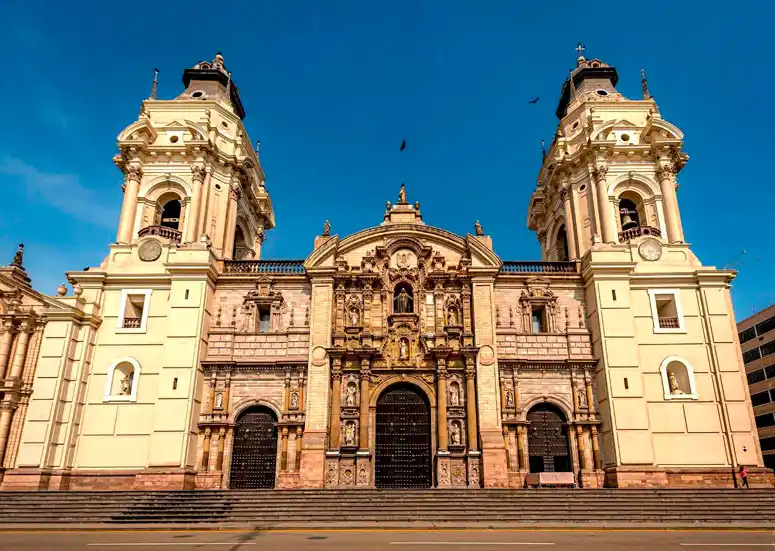
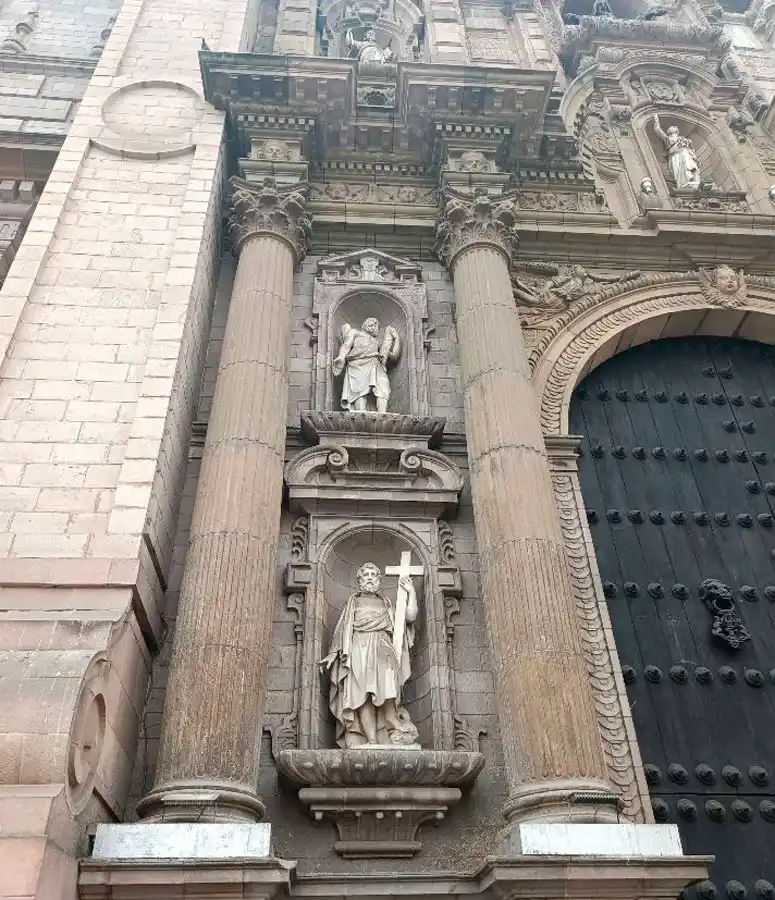


That’s why many say that the only wooden cathedral in Peru is found right here in Lima. Beyond that unique detail, your guide will point out the blend of Spanish and Indigenous iconography that decorates the temple’s façade.
The Cathedral features three large entrance doors, each symbolising something different: forgiveness, the gospel, and the epistle. One curious detail to look out for is the carved hat next to the Sacred Heart of Jesus — known as Pizarro’s hat.
During your visit, be sure to ask your guide about the story behind the equestrian statue of Francisco Pizarro, which was placed in front of the Cathedral in 1935. You’re in for a surprise!

Nave of the church of Santo Domingo
It’s one of the first religious buildings in the capital and a true gem of colonial architecture. Construction began in 1535, the same year Lima was founded by the Spanish, on land that once belonged to the Indigenous chief Taulichusco. Originally conceived as a spiritual and educational centre, its naves were altered between the 16th and 18th centuries. They stand out for their neoclassical style, spaciousness, and harmonious proportions.
Its centuries-old cloisters “witnessed” the lives of Saint Rose of Lima — the first saint of the Americas — Saint John Macías, one of Peru’s early evangelisers, and Saint Martin de Porres, the first mixed-race person to be canonised.
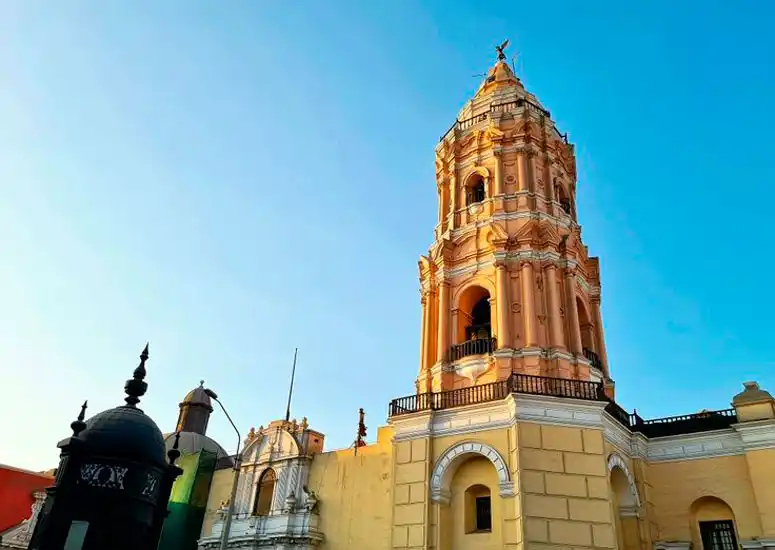

Known as “the saint of the broom”, Martin de Porres (1579–1639) was the son of a Spanish nobleman and a Black woman from Panama. At the age of 15, he joined the Convent of Santo Domingo at the invitation of Friar Juan de Lorenzana.
Due to his status as an illegitimate child, he was assigned humble duties for nine years. But thanks to his kindness and love for God, he was admitted as a Dominican lay brother in 1603 — a step that marked the beginning of his path to sainthood.
Remembered as a humble man who cared for the sick and supported the poor, Saint Martin de Porres was canonised on 6 May 1962 at the Vatican by Pope John XXIII.

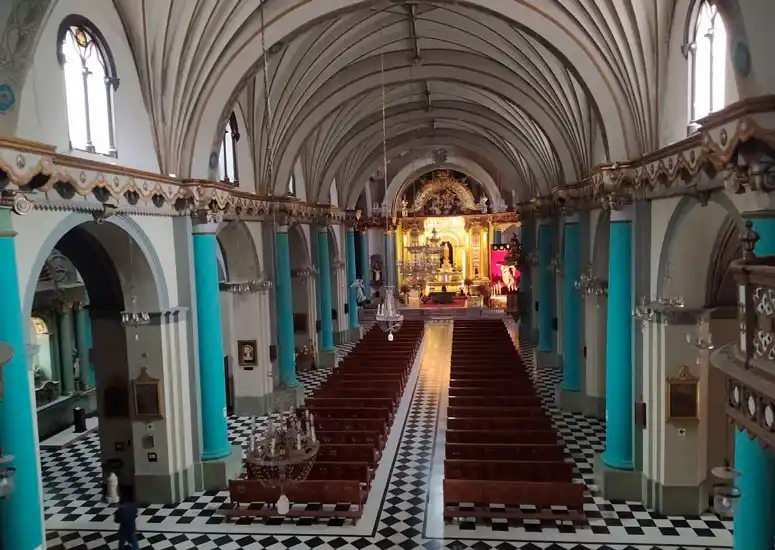
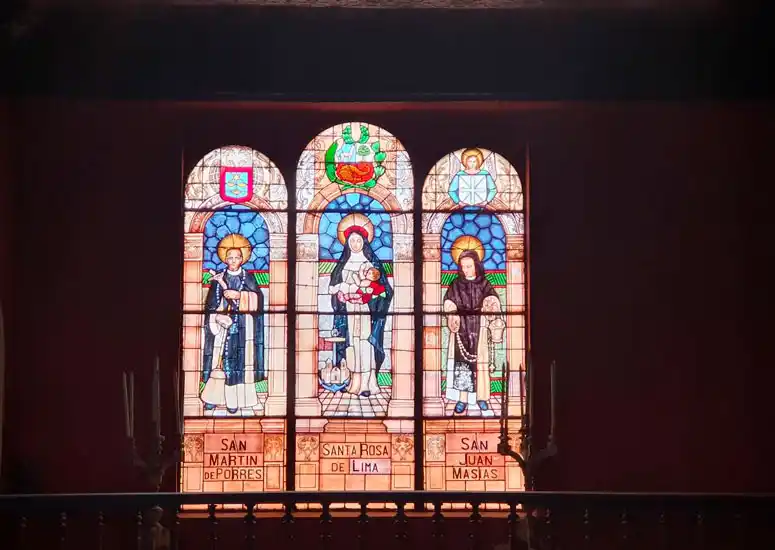
Peruvian house of literature
In 2009, the Desamparados Station was transformed into a space dedicated to promoting reading, showcasing the works of Peruvian authors, and strengthening national identity through the words of our great writers and thinkers.
Inaugurated in 1912 by President Augusto B. Leguía, Desamparados — located on the left bank of the Rímac River, just behind the Government Palace — was once the main station of the Central Railway, linking the port of Callao with Cerro de Pasco.
This journey from the coast to the highlands included passing through Ticlio (4818 m above sea level), which for many years held the title of the highest railway point in the world. Nowadays, the line is mainly used for freight transport.
Left “desamparada” (abandoned) due to the lack of passengers, the station — designed by architect Rafael Marquina and built near the Church of Nuestra Señora de los Desamparados — was carefully restored to serve its new cultural role.
Its original stone-carved façade and striking clock were preserved, as were its high-ceilinged halls and colourful 20th-century stained-glass windows.
Today, the Casa de la Literatura Peruana offers exhibition rooms and interactive spaces for children and young people. Its library holds treasured works by César Vallejo, José María Arguedas, Blanca Varela, Ricardo Palma, and Mario Vargas Llosa.





Pisco tasting (optional)
Cheers to the Historic Centre. Cheers to Peru and its national drink. Cheers with and for pisco — the refined grape brandy that began production in the 16th century, when the first European vines started to bear fruit in the Ica Valley.
Thanks to its deep historical and cultural roots, pisco is far more than just a drink. It’s identity, it’s pride, it’s purity — because no additives are used in its traditional production, and the spirit is never aged in wood.
The result is a clear, high-proof brandy that was highly valued in colonial Peru. Back then, it was shipped from the port of Pisco — south of Lima — to various destinations across the world.
The Peruvian origin of pisco is supported by multiple historical records, some dating back to the 17th century. Today, the denomination of origin is reserved for producers in Lima, Ica, Arequipa, Moquegua, and Tacna only.
During the free tour, we’ll take a break so you can try either pure pisco or the famous pisco sour — Peru’s signature cocktail. We promise that with every sip, you’ll taste the essence of our land.
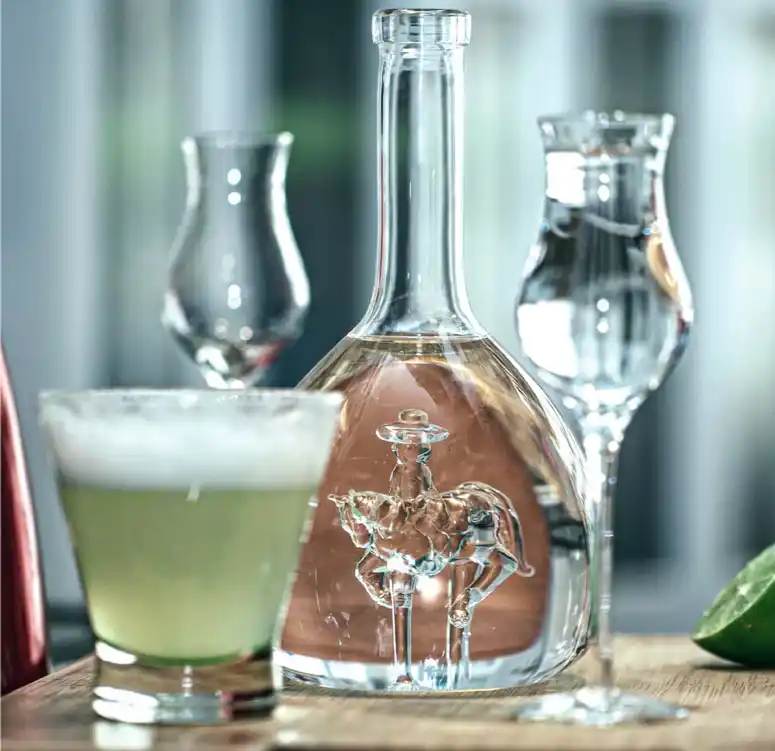
Convent and church of San Francisco (exterior visit)
After tasting the truly Peruvian pisco, you’ll come face to face with the façade of the San Francisco convent and church — one of the most remarkable religious architectural complexes in all of the Americas.
Construction of this monumental symbol of faith began in 1542, though the convent itself wasn’t officially inaugurated until 1672. At this stop, your guide will tell you all about the eerie catacombs of San Francisco, where the remains of around 36,000 people are laid to rest.
If you’re curious to explore the catacombs, we highly recommend returning to the convent for an indoor tour. It’s an unforgettable experience that brings you closer to the spiritual world of old Lima.



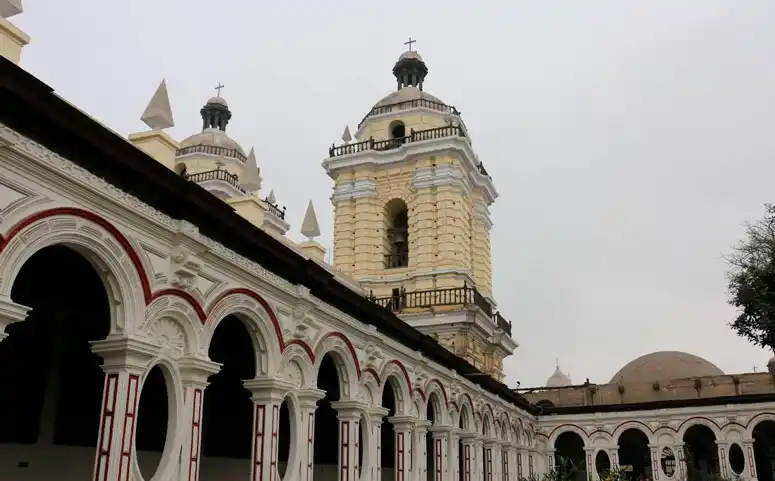

Parque de la Muralla (Wall Park)
For two centuries, Lima was a fortified city. Due to its wealth and strategic location in Spanish America, Peru’s present-day capital was a prized target for pirates and privateers sailing the Pacific Ocean.
Faced with this uncertain situation, the colonial authorities decided to build a defensive structure to protect the city. In 1684, Viceroy Melchor de Navarra y Rocafull, Count of La Palata, ordered construction to begin.

Built with lime and stone, the wall featured 11 access gates, along with bastions and moats. At the time, it was considered an ambitious project. The massive fortification surrounded what we now know as Cercado de Lima, or Lima’s historic centre.
Over time, however, the defensive wall became a barrier that restricted the city’s growth. That’s why, in 1868, President and Grand Marshal of Peru Ramón Castilla ordered its demolition.

Despite that presidential decree, traces of the old protective walls can still be seen today. In 2004, the Park of the Wall (Parque de la Muralla) was inaugurated along the banks of the Rímac River, where you’ll spot original sections of the grand old fortifications.
With its wide gardens, cultural spaces, and scenic viewpoints, this park will be your final stop on the walking tour of Lima’s historic centre — a city that was, quite literally, “trapped” by its own greatness for 200 years.


End of the tour
The free tour concludes at Lima’s Plaza de Armas at approximately 13:30 hours (morning session) and 17:00 hours (afternoon session).
TIMETABLE
| Schedules | Starts in | Language | Duration | |
|---|---|---|---|---|
| 10:00 | From Monday to Saturday | Miraflores (pick-up) | English | 3.5 h |
| 11:00 | Historic center | 2.5 h | ||
| 15:00 | ||||
| 10:00 | From Monday to Saturday | Miraflores (pick-up) | Spanish | 3.5 h |
| 11:00 | Historic center | 2.5 h | ||
| 15:00 | ||||
| We don’t operate on July 28, August 30, and January 1. The tour duration is approx. | ||||
If you’d like to book your Lima free tour for Sunday, please visit this link.
MEETING PLACES
At our meeting places, look for the yellow vest with the FWTP – IMW logo.
| Schedule | Meeting Places | Remarks |
|---|---|---|
| 10:00 | Pasaje Porta 132 (outside Oechsle Mall) in Miraflores (pick-up). | You MUST read Faqs below before joining us in Miraflores. Bring 3.20 soles pp for the metro-bus ticket. |
| 11:00 | Jirón de la Unión Street 608 (in front of La Merced Church) in Lima historic center. | Take a taxi o Uber beforehand. |
| 15:00 |
10:00 in Miraflores: Oechsle Mall

11:00 & 15:00: At La Merced Church

Look for

Faqs
What is the pick-up point in Miraflores?
We know that many travellers stay in the Miraflores district and may find it tricky to reach Lima’s historic centre due to the traffic and distance. That’s why we’ve set up a special pick-up point in Miraflores – but only for the 10:00 a.m. schedule.
Once everyone is gathered, we’ll walk together to the bus station and take the well-known Metropolitano express bus. The journey takes around 30 to 40 minutes. We’ll arrive near La Merced Church at approximately 11:00 a.m.
Don’t forget to bring some cash – only in Peruvian soles – for your bus ticket.
Who can come to our pick-up point in Miraflores?
Only travellers who are staying very close to our pick-up point (please consider the walking time from your hotel to the pick-up point). Miraflores is a very large district, so distance matters.
If you’re not within walking distance of the pick-up point, we recommend heading straight to the main meeting point at either 11:00 or 15:00. Please, note that the walking tour takes place in Lima’s historic centre – not in Miraflores.
How do I get to Lima’s historic center on my own?
Please visit this link.
Where does this tour end?
Our Lima free tour ends near the Plaza de Armas, in the historic centre of Lima. To return to Miraflores or Barranco, you can take the same Metropolitano express buses. For more details, feel free to ask your guide at the end of the tour.
Elderly travellers, children, or anyone with specific transport preferences
Please note: The Metropolitano express buses are part of Lima’s public transport system, mainly used by local passengers. The buses are large and clean – a great option if you want to save money. However, especially during peak hours, they can get very crowded.
For this reason, if you’re travelling with children, elderly people, or if you simply prefer a more private and comfortable experience, we strongly recommend taking an Uber or taxi and heading straight to the main meeting point at 11:00 or 15:00 schedule. Please do not come to the Miraflores pick-up point.
PRICE
Free – based on your donation, neither our tour guides nor the team members have set salaries.
Please, bring cash in Peruvian soles, US dollars or Euros for tips. We do not accept cards, bank transfers or other currencies.
DETAILS
Tour Type: Group tour, no private service.
Restrictions:
- People with reduced mobility.
- Peruanos: Ningún estudiante de turismo, guía de turismo, estudiante de inglés, agente de viaje peruano será aceptado.
- Si eres peruano reserva el city tour de Lima.
Included: Professional tour guide.
What do I bring?
- April-Nov:
- Sweaters.
- Dec-March:
- Sunscreen.
- Sunglasses.
- Hats.
- A bottle of water.
- Miraflores (pick-up):
- Bring 3.20 soles pp for the bus ticket.
- * Bring coins, we don’t have small coins to give you the change.
- * If you don’t have small coins, you can give 3.50 soles pp; but we’ll not give any change.
- Cash (Peruvian soles, American dollars or Euros) for the tip.
WhatsApp:
REVIEWS
Please, scroll down to see reviews.
REVIEWS
⭐Google Maps: 900 reviews | ⭐TripAdvisor: 400 testimonials | ⭐Facebook: 50 comments | ⭐Instagram: 5000 followers | ⭐YouTube: watch our videos | ⭐Travellers: + de 70,255 tourists

